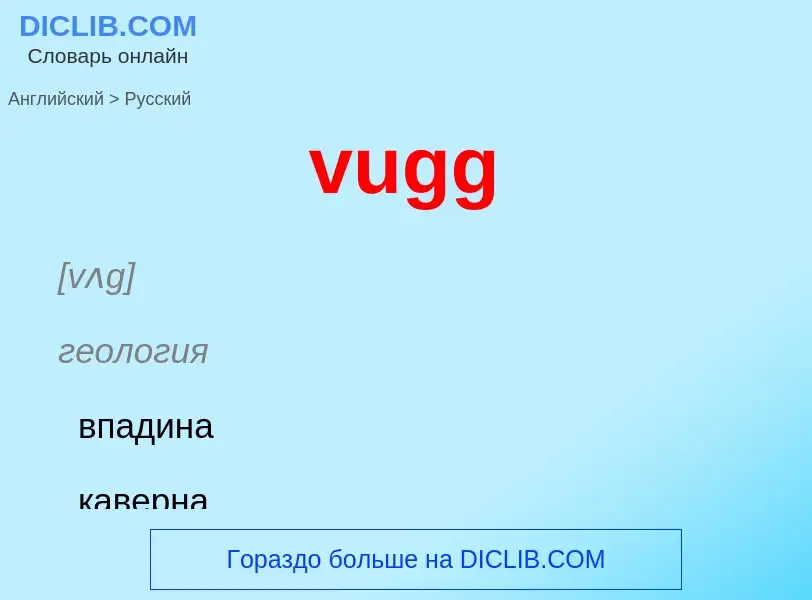Vertaling en analyse van woorden door kunstmatige intelligentie ChatGPT
Op deze pagina kunt u een gedetailleerde analyse krijgen van een woord of zin, geproduceerd met behulp van de beste kunstmatige intelligentietechnologie tot nu toe:
- hoe het woord wordt gebruikt
- gebruiksfrequentie
- het wordt vaker gebruikt in mondelinge of schriftelijke toespraken
- opties voor woordvertaling
- Gebruiksvoorbeelden (meerdere zinnen met vertaling)
- etymologie
vugg - vertaling naar russisch
[vʌg]
геология
впадина
каверна
полость
трещина
существительное
геология
впадина
каверна
полость
трещина
[vʌg]
геология
впадина
каверна
полость
трещина
существительное
геология
впадина
каверна
полость
трещина
Wikipedia
A vug, vugh, or vugg () is a small- to medium-sized cavity inside rock. It may be formed through a variety of processes. Most commonly, cracks and fissures opened by tectonic activity (folding and faulting) are partially filled by quartz, calcite, and other secondary minerals. Open spaces within breccias formed by an ancient collapse are another important source of vugs.
Vugs may also form when mineral crystals or fossils inside a rock matrix are later removed through erosion or dissolution processes, leaving behind irregular voids. The inner surfaces of such vugs are often coated with a crystal druse. Fine crystals are often found in vugs where the open space allows the free development of external crystal form.
The term vug is not applied to veins and fissures that have become completely filled, but may be applied to any small cavities within such veins. Geodes are a common vug-formed rock, although that term is usually reserved for more rounded crystal-lined cavities in sedimentary rocks and ancient lavas.
The word vug was introduced to the English language by Cornish miners, from the days when Cornwall was a major supplier of tin. The Cornish word was vooga, which meant "cave".

![A vug in a [[limonite]] matrix is the host for a layer of green botryoids of [[conichalcite]] and colorless, translucent rhombs of calcite A vug in a [[limonite]] matrix is the host for a layer of green botryoids of [[conichalcite]] and colorless, translucent rhombs of calcite](https://commons.wikimedia.org/wiki/Special:FilePath/Conichalcite-Calcite-65643.jpg?width=200)
![Vug with rosettes of deep blue [[azurite]] on a field of malachite Vug with rosettes of deep blue [[azurite]] on a field of malachite](https://commons.wikimedia.org/wiki/Special:FilePath/Azurite-Malachite-163967.jpg?width=200)
![[[Goosecreekite]] with [[heulandite]]-Ca on quartz [[Goosecreekite]] with [[heulandite]]-Ca on quartz](https://commons.wikimedia.org/wiki/Special:FilePath/Goosecreekite-Heulandite-Ca-Quartz-indi-41a.jpg?width=200)
![Intergrown botryoids of blue-green [[rosasite]] inside the curve of a limonite vug Intergrown botryoids of blue-green [[rosasite]] inside the curve of a limonite vug](https://commons.wikimedia.org/wiki/Special:FilePath/Rosasite-rosa08a.jpg?width=200)

![Apple green [[pyromorphite]] cluster on limonite matrix Apple green [[pyromorphite]] cluster on limonite matrix](https://commons.wikimedia.org/wiki/Special:FilePath/Pyromorphite-t07-109a.jpg?width=200)
![Vug in a limonitic matrix is the host for bi-pyramidal, brownish-red crystals of [[wulfenite]] Vug in a limonitic matrix is the host for bi-pyramidal, brownish-red crystals of [[wulfenite]]](https://commons.wikimedia.org/wiki/Special:FilePath/Wulfenite-181388.jpg?width=200)
![Crystallized [[groutite]] scattered about a hollow vug Crystallized [[groutite]] scattered about a hollow vug](https://commons.wikimedia.org/wiki/Special:FilePath/Groutite-tuc1048a.jpg?width=200)
![inclusion]]s of fibrous [[aurichalcite]] inclusion]]s of fibrous [[aurichalcite]]](https://commons.wikimedia.org/wiki/Special:FilePath/Aurichalcite-Calcite-aur06a.jpg?width=200)
![[[Stellerite]], [[epistilbite]], and [[eluorapophyllite]] in a basaltic vug [[Stellerite]], [[epistilbite]], and [[eluorapophyllite]] in a basaltic vug](https://commons.wikimedia.org/wiki/Special:FilePath/Epistilbite-Fluorapophyllite-Stellerite-indi-20a.jpg?width=200)
![Nestled in its matrix vug are five golden-yellow crystals of [[sulfur]] Nestled in its matrix vug are five golden-yellow crystals of [[sulfur]]](https://commons.wikimedia.org/wiki/Special:FilePath/Sulfur-tmix07-162b.jpg?width=200)
![In an open pocket in a matrix of limonite there is a cluster of deep robin's-egg blue [[chrysocolla]] with a covering of [[drusy]] quartz In an open pocket in a matrix of limonite there is a cluster of deep robin's-egg blue [[chrysocolla]] with a covering of [[drusy]] quartz](https://commons.wikimedia.org/wiki/Special:FilePath/Quartz-Chrysocolla-193915.jpg?width=200)
